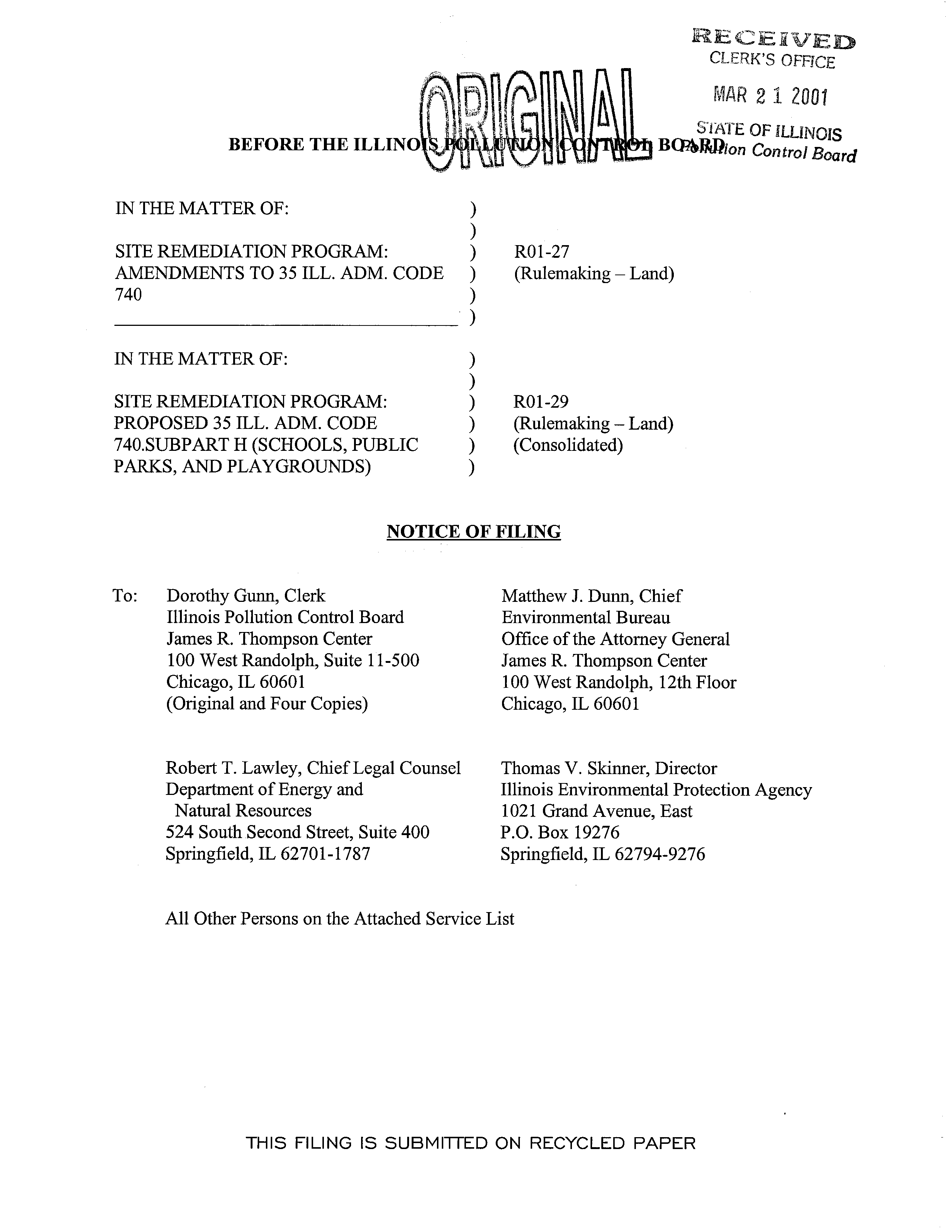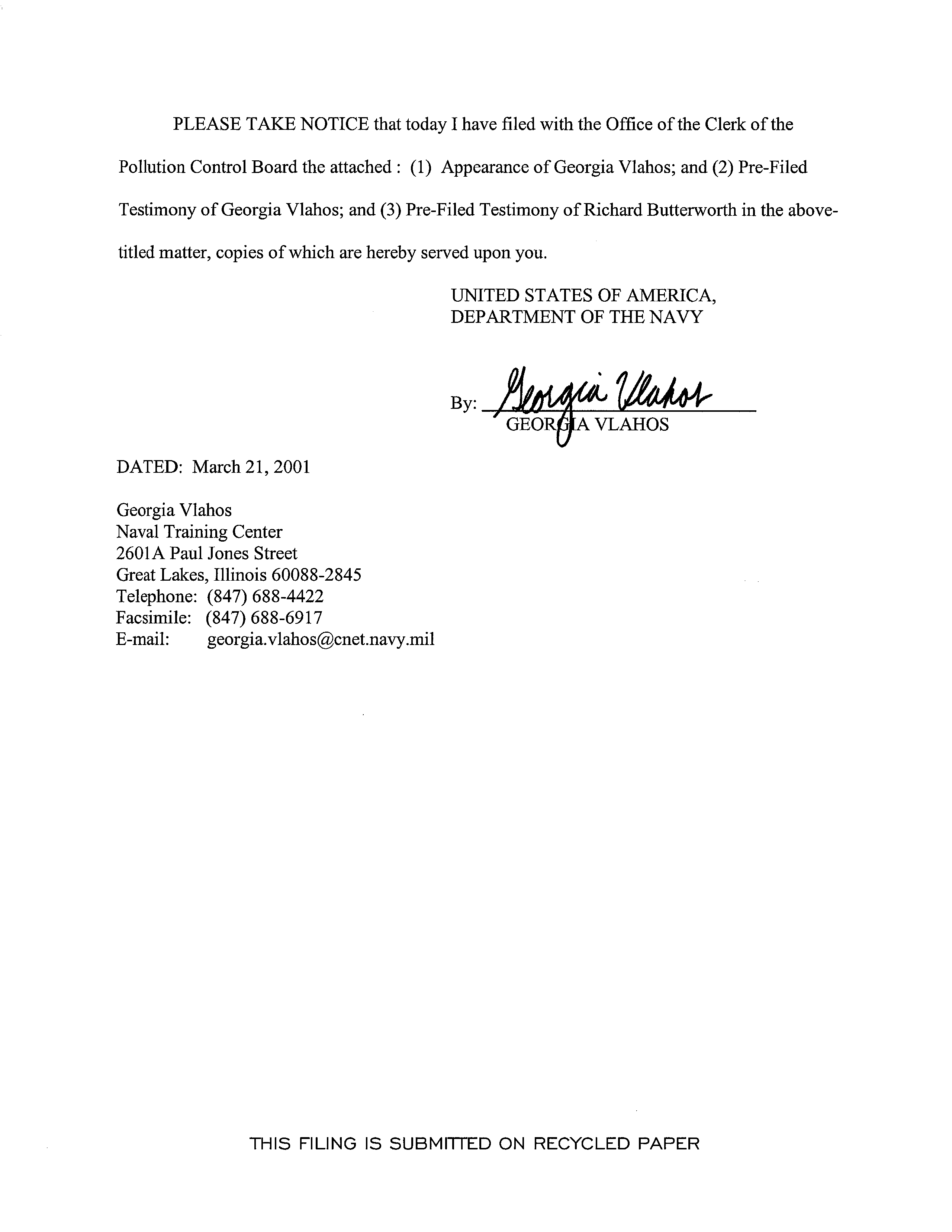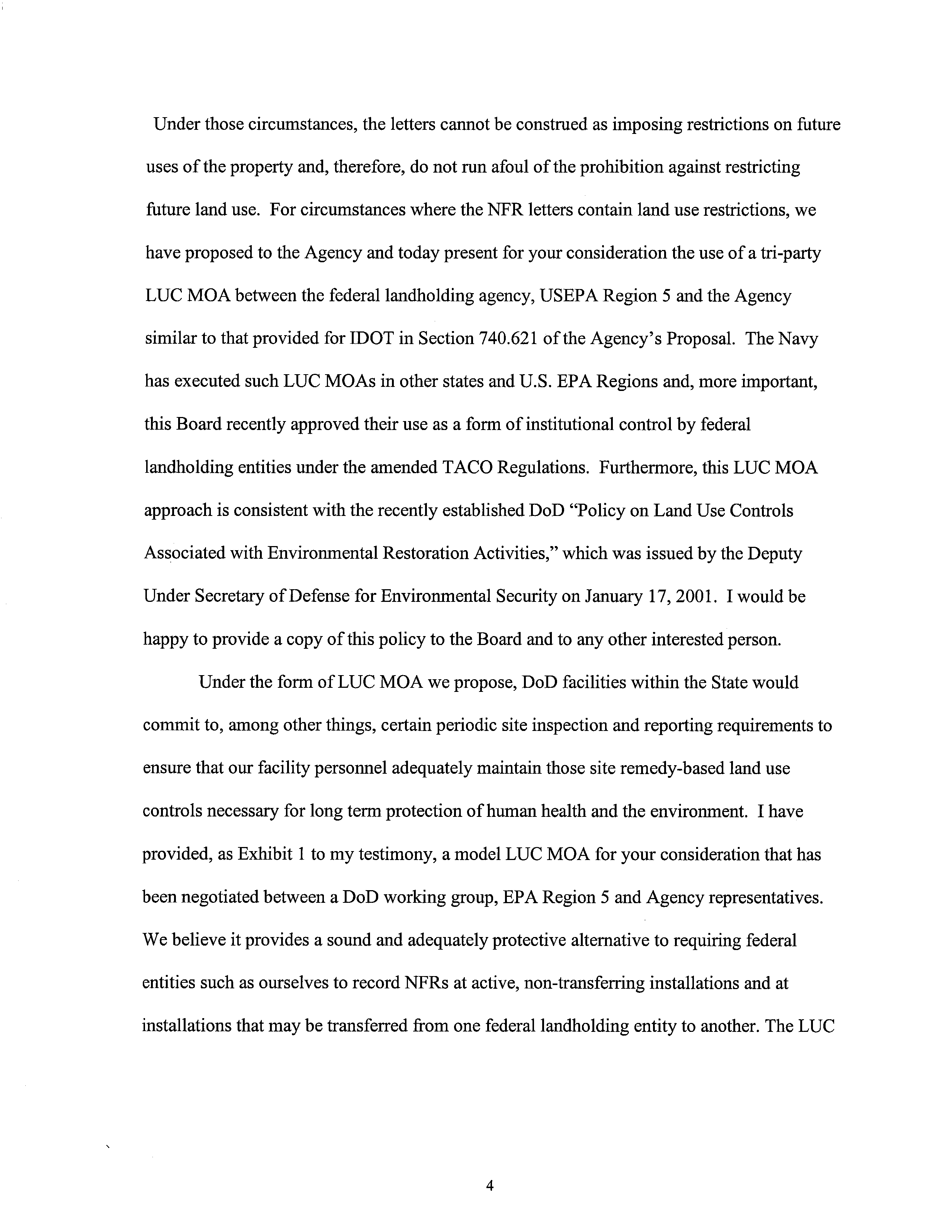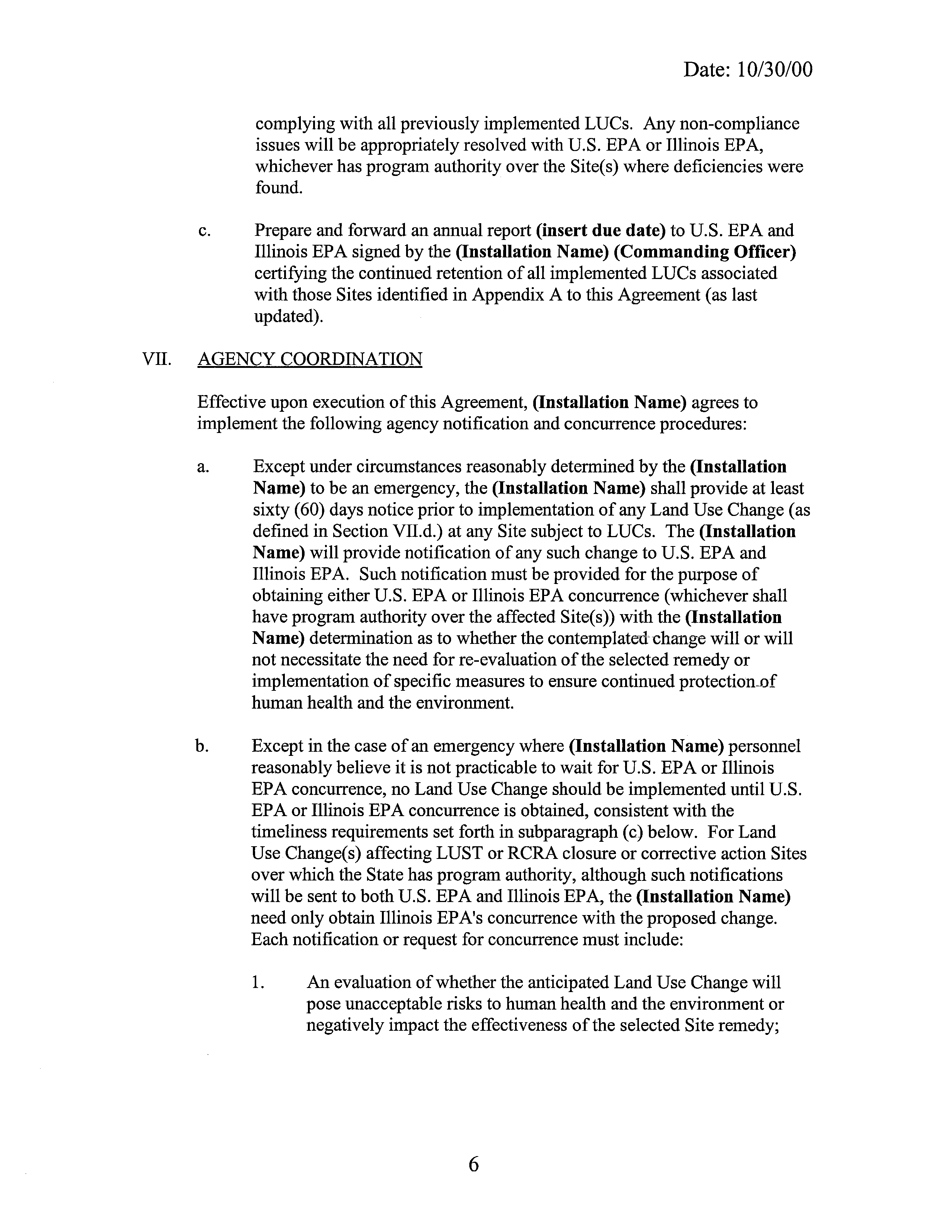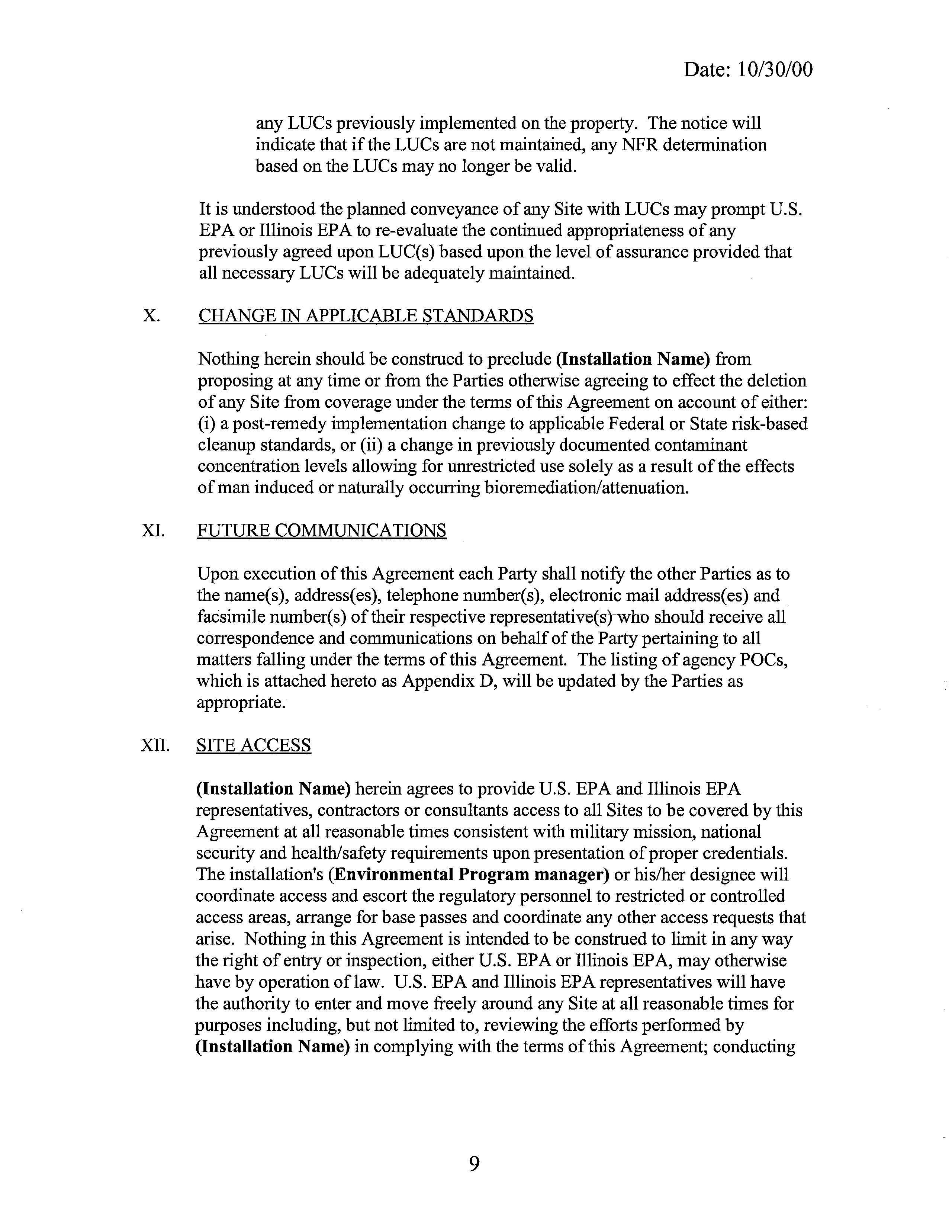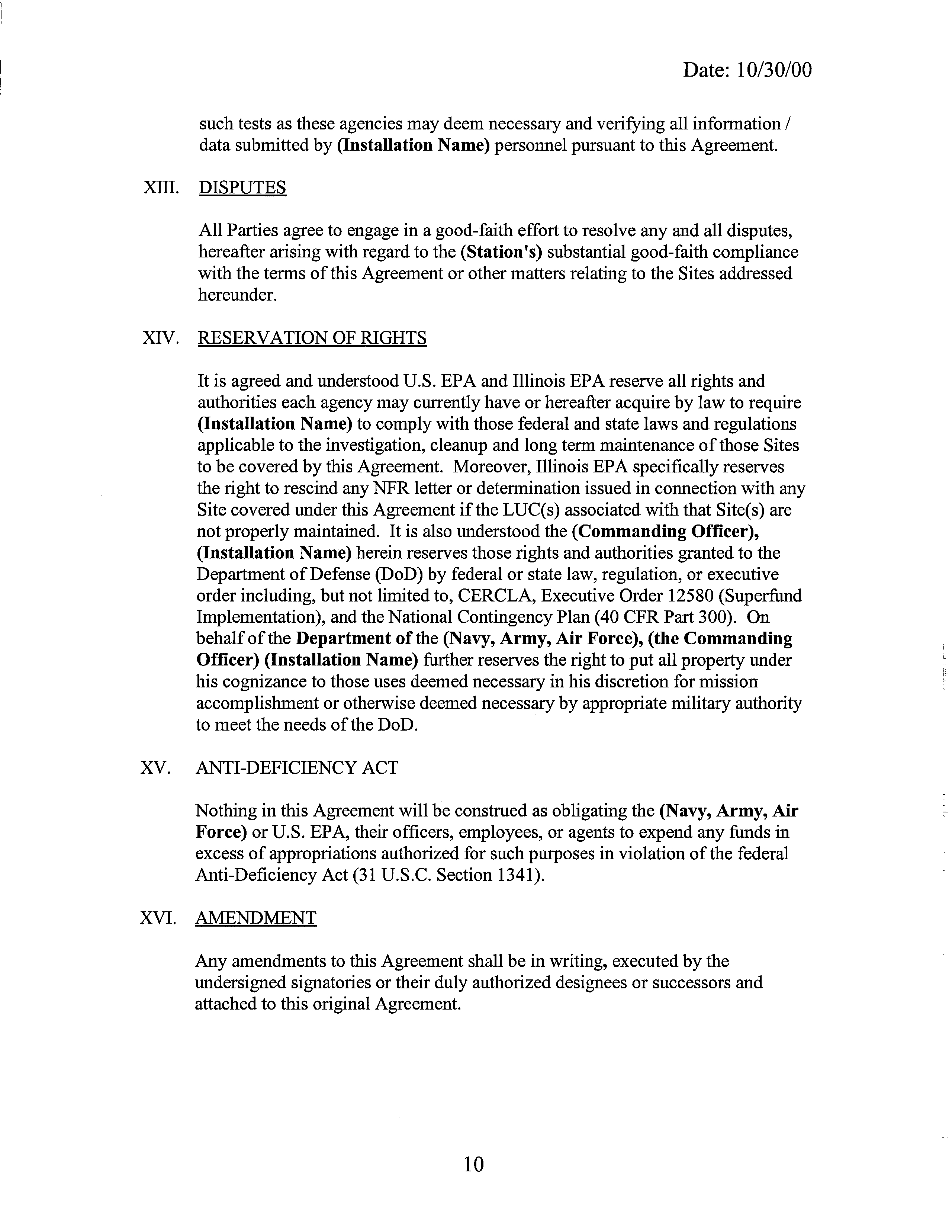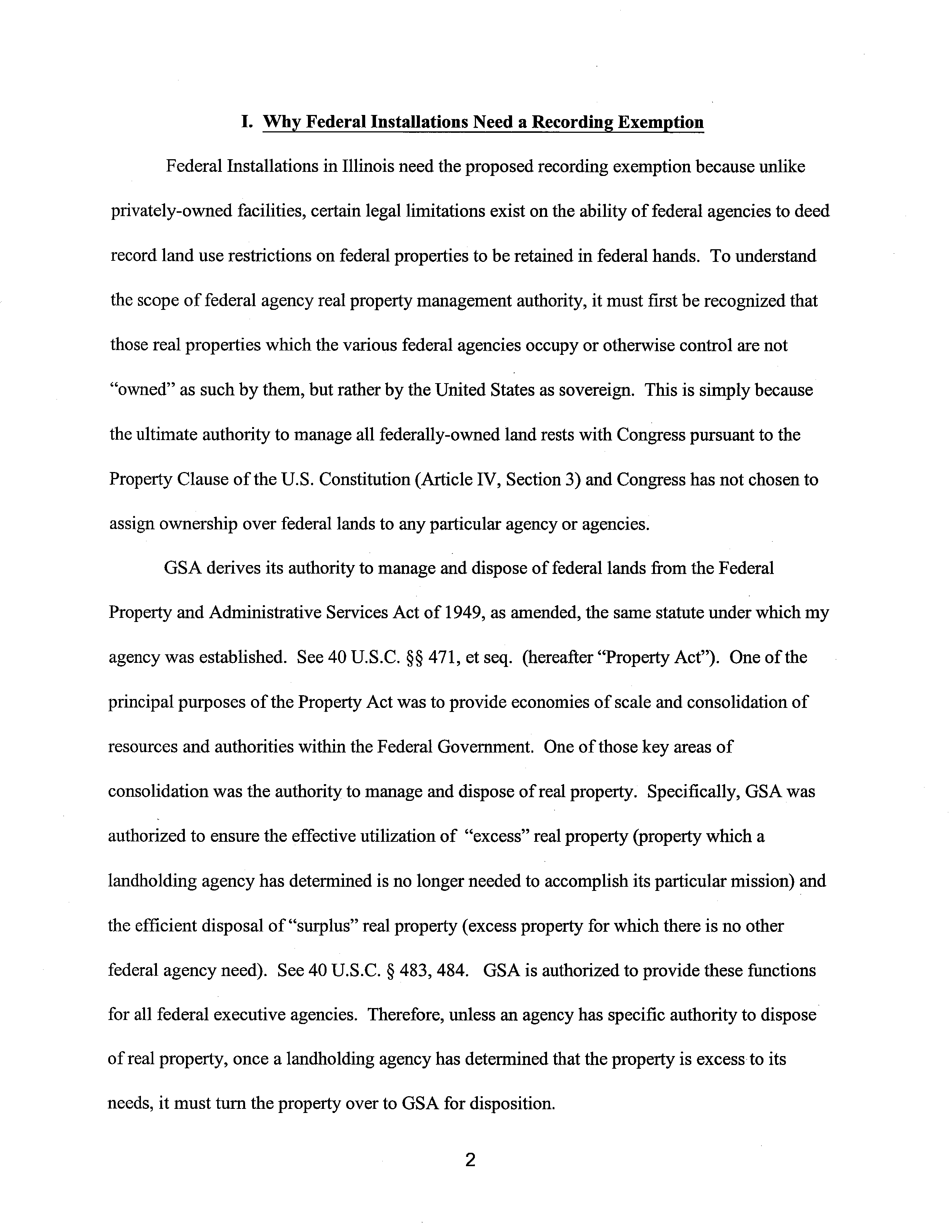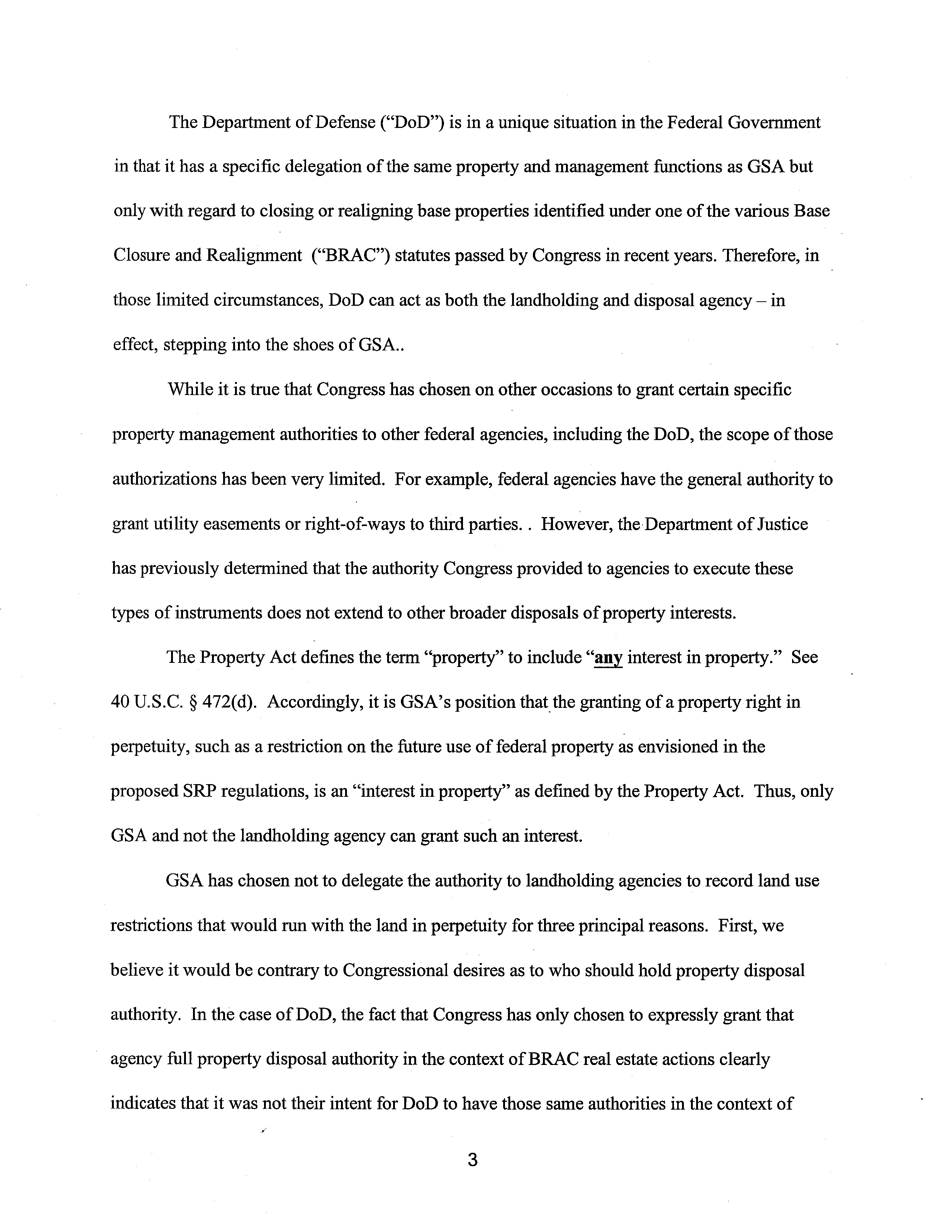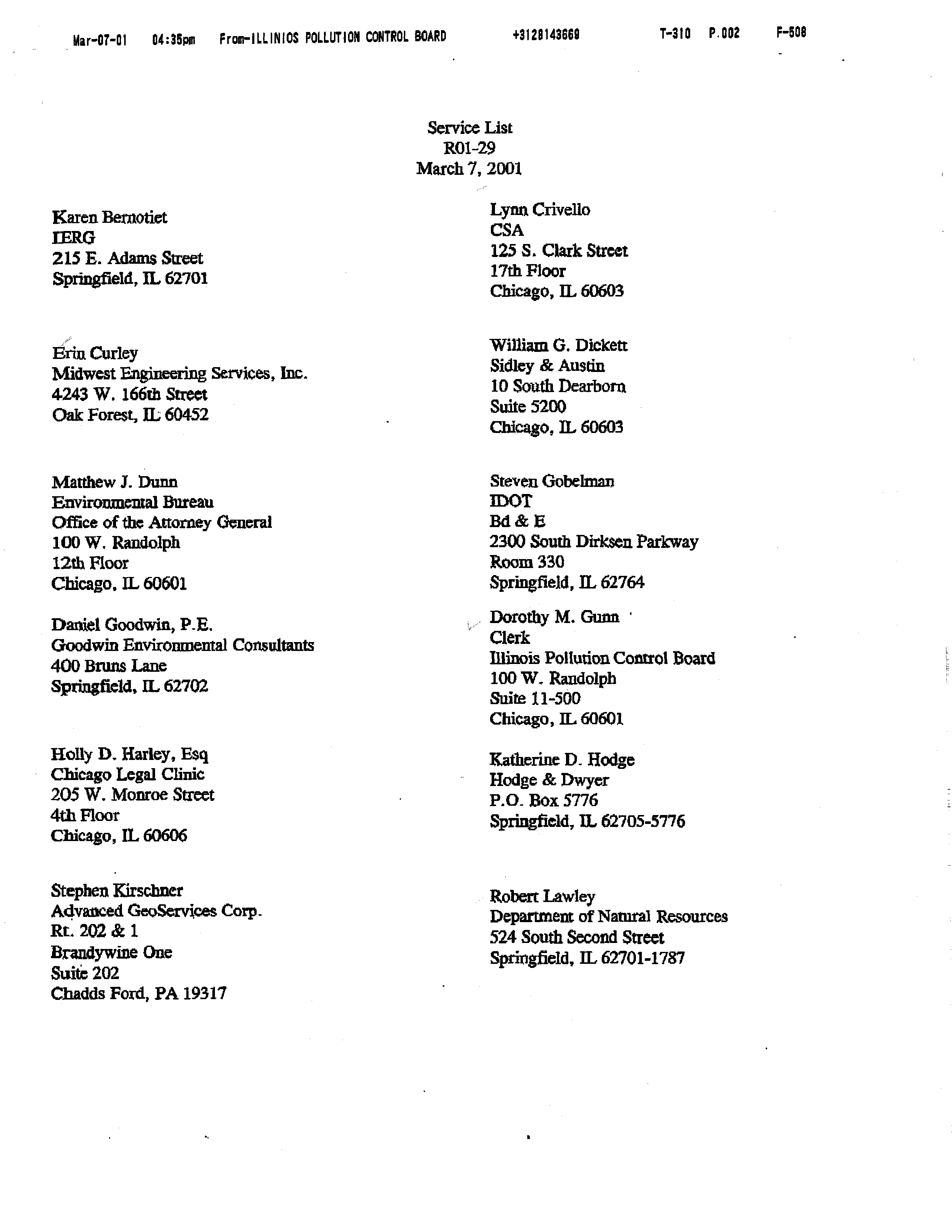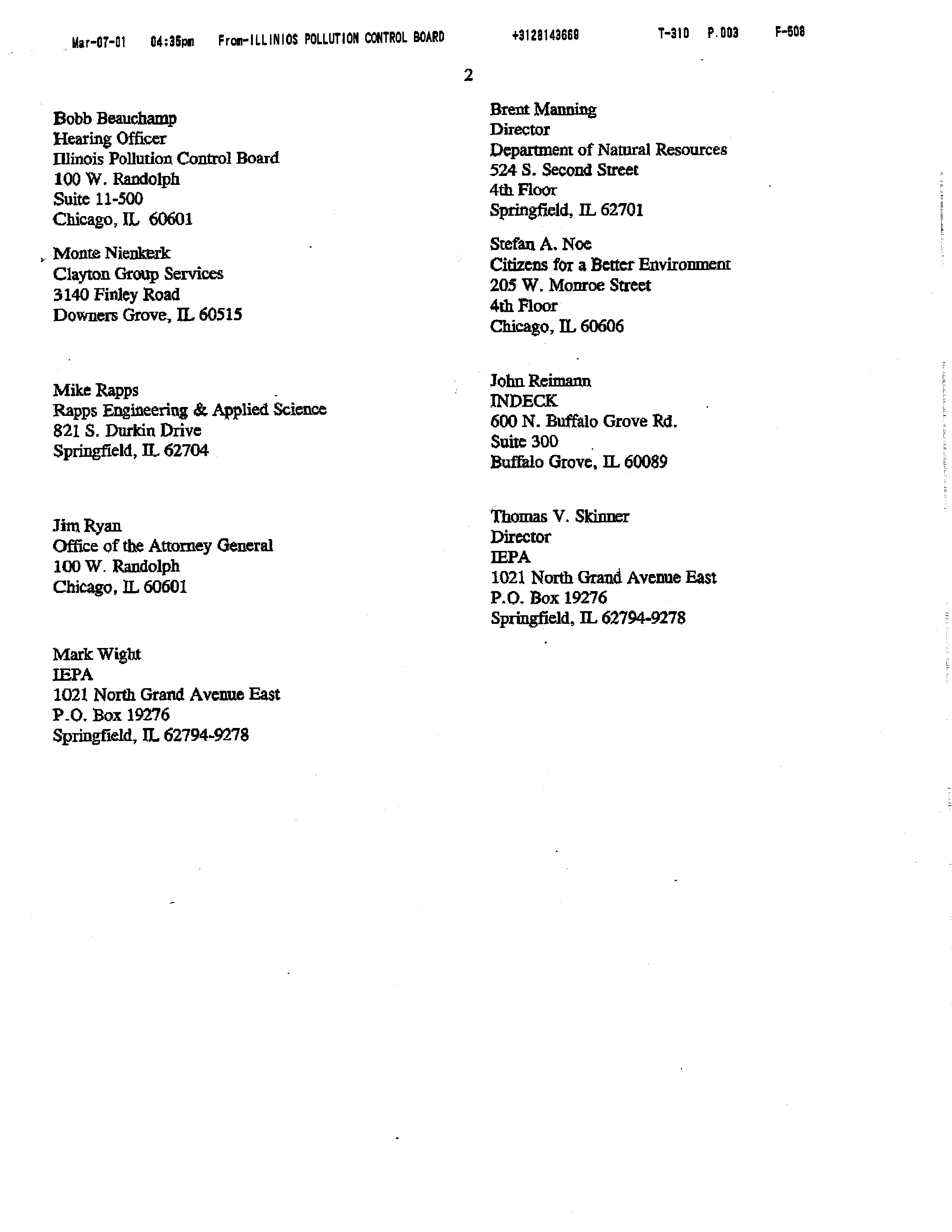| | - BEFORE THE
- NOTICE OF FILING
- APPEARANCE
- PRE-FILED TESTIMONY OF GEORGIA VLAHOS
- II. Why an exception should be made for federal facilities
- III. Conclusion
- ILLINOIS EPA
- I. Why Federal Installations Need a Recording Exemption
- I. Why Federal Installations Need a Recording Exemption
- Springfield, IL 62764
- Dorothy Id. GiumClerk
- Springfield, It 62701-1787
- ~ Stephen KirachuerAdvanced GeoServices Coip.
- Brent ManningDireaor
- Karen L. BernoteitIERG
- Mike R.appsRapps Engineering & Applied Science821 S. Duricin Drive
-
- Thomas V. SkinnerDirector
- Springfield, IL 62794-9278
- Springfield, IL 62794-9278
- Georgia ViahosU.S. Navy
- 2601A Paul Jones StreetGreat Jskes, IL 60088-2845
- Service ListRO1-29March7,2001
- 125 3. Clark Street17thFloor
- oak Forest, IL 60452
- Springfield, IL 62702
- Holly D. Harley. EsqCbicago Legal Clinic205 W. Monroe Street4th Floor
- Chicago, IL 60606
- Brandywine OneSuite 202
- Bd&E2300 South Diriceen ParkwayRoom 330
- Springfield, IL 62764
- Springfield, IL 62701-1787
- Karen BernotietIERG
- Springfield, IL 62704
- 4th FloorChicago, IL 60606
- John ReimannINDECK
- Mark WightIEPA
|
BEFORE THE
IN THE MATTER OF:
SITE REMEDIATION PROGRAM:
AMENDMENTS TO 35 ILL. ADM. CODE
740
IN THE MATTER OF:
SITE REMEDIATION PROGRAM:
PROPOSED
35
ILL. ADM. CODE
740.SUBPART H (SCHOOLS, PUBLIC
PARKS, AND PLAYGROUNDS)
)
)
)
)
E~
CLERK’S OFFCE
~1~R
2
12001
SThTE OF
ILLIr’QIS
~
Control Board
RO 1-27
(Rulemaking
—
Land)
)
)
)
)
)
)
ROl-29
(Rulemaking
—
Land)
(Consolidated)
NOTICE
OF FILING
To:
Dorothy Gunn, Clerk
Illinois Pollution Control Board
James R. Thompson Center
100
West Randolph, Suite 11-500
Chicago, IL 60601
(Original and Four Copies)
Robert T. Lawley, Chief Legal Counsel
Department ofEnergy and
Natural Resources
524
South Second Street, Suite 400
Springfield, IL
62701-1787
Matthew J. Dunn, Chief
Environmental Bureau
Office ofthe Attorney General
James R. Thompson Center
100 West Randolph,
12th Floor
Chicago, IL 60601
Thomas V. Skinner, Director
Illinois Environmental Protection Agency
1021
Grand Avenue, East
P.O. Box 19276
Springfield,
IL 62794-9276
All Other Persons on the Attached Service List
)
)
THIS
FILING IS SUBMIlTED
ON
RECYCLED
PAPER
PLEASE TAKE NOTICE that today I have filed with the Office ofthe Clerk ofthe
Pollution Control Board the attached:
(1)
Appearance of Georgia Vlahos; and (2) Pre-Filed
Testimony ofGeorgiaVlahos; and
(3) Pre-Filed Testimony ofRichard Butterworth in the above-
titled matter, copies ofwhich are hereby served upon you.
UNITED STATES OF AMERICA,
DEPARTMENT OF THE NAVY
By:
GEOR A
DATED:
March 21, 2001
Georgia Vlahos
Naval Training Center
2601A Paul Jones Street
Great Lakes, Illinois
60088-2845
Telephone:
(847) 688-4422
Facsimile:
(847) 688-6917
E-mail:
georgia.vlahos@cnet.navy.mil
THIS
FILING
IS
SUBMIlTED
ON
RECYCLED
PAPER
RECEI~,I3D
CLERK’SOF ~CE
MAR
2
12001
BEFORE THE
ILLINOIS POLLUTION CONTROL BOARD
STATE OF
ILLINOIS
Pollution
Control Board
IN THE MATTER
OF:
SITE REMEDIATION PROGRAM:
AMENDMENTS TO
35
ILL. ADM. CODE
740
)
)
)
)
)
RO 1-27
(Rulemaking
—
Land)
IN THE MATTER OF:
)
)
SITE REMEDIATION PROGRAM:
PROPOSED
35
ILL. ADM. CODE
740.SUIBPART H (SCHOOLS, PUBLIC
PARKS, AM) PLAYGROUM)S)
)
RO1-29
)
(Rulemaking
—
Land)
)
(Consolidated)
)
APPEARANCE
I hereby file my appearance in this proceeding on behalf ofthe United
States of
America, Department ofthe Navy.
UNITED STATES
OF AMERICA,
DEPARTMENT OF THE NAVY
By:
GEOR
AVLAHOS
DATED:
March 21, 2001
Georgia Viahos
Naval Training Center
2601A Paul Jones Street
Great Lakes, Illinois 6008 8-2845
Telephone:
(847) 688-4422
Facsimile:
(847) 688-6917
E-mail:
georgia.vlahos@cnet.navy.mil
RECEIVED
CT FRK’SOFFIrF
MAR
2
12001
BEFORE THE ILLINOIS POLLUTION CONTROL BOA~U~ E
OF ILLINOiS
Pollution
Control Board
IN THE MATTER OF:
)
)
SITE REMEDIATION PROGRAM:
)
ROl-27
AMENDMENTS TO
35
ILL. ADM. CODE
)
(Rulemaking Land)
740
)
IN THE MATTER OF:
)
)
SITE REMEDIATION PROGRAM:
)
ROl-29
PROPOSED
35
ILL. ADM. CODE
)
(Rulemaking
-
Land)
740.SUBPART H (SCHOOLS, PUBLIC
)
(Consolidated)
PARKS, AND PLAYGROUNDS)
)
PRE-FILED TESTIMONY OF GEORGIA VLAHOS
Good morning, my name is Georgia Viahos.
I am Counsel to the Commander of
Naval Training Center Great Lakes located in North Chicago, Illinois.
My duties include
advising the Commander in his capacity as the Department ofthe Navy’s Regional
Environmental Coordinator for USEPA Region
5,
an area that, of course, includes the
State
ofIllinois.
In this regard, I assist the Command in coordinating environmental policy among
the various Naval and other Department ofDefense (“DoD”) components in the Region
concerning,
among other things, those pertaining to environmental compliance,
environmental restoration and property disposal.
My testimony here was developed in consultation with other DoD
component
agencies.
On behalf ofthe Navy and the other military services, I thank you for the
opportunity to be here today and provide you with our views on the revisions to the Part 740
Site Remediation Program (“SRP”)regulations proposed by the Illinois Environmental
Protection Agency (the “Agency”). I shall refer to these revisions as the “Agency Proposal.”
The Agency Proposal introduces the concept of “perfecting” No Further
Remediation (“NFR”) letters byrecording them in county land records.
As will be addressed
in testimony to be presented to you todayby a representative ofthe General Services
Administration, this recording requirement is problematic for federaLlandholding entities.
This is because federal
entities do not generally “own” the federal lands
on which they
operate and, therefore, have no legal authority to record restrictions on the future use ofthat
land.
I appear before you to present an alternative to
this recording requirement for the
Navy and other federal landholding agencies in Illinois.
Our proposal reflects our desire to
apply the Land Use Control Memorandum ofAgreement (“LUC MOA”)concept, which was
recently incorporatedby the Board into the TACO rules in Part 742, into the Part 740
regulations for the Site Remediation Program (“SRP”).
At this point, I must note that, by suggesting revisions to the Agency’sproposal, we in
the DoD
community do not mean to imply that we view every effort we undertake to address
hazardous substance contamination on our facilities as subject to SRP requirements.
As I’m
sure this Board is aware, unlike the private sector, DoD has its own independent CERCLA
lead agency authorities which allow us to deal directly with hazardous substance releases on,
or from, our facilities.
However, we believe there could well be times where wemight want
to seek a KFR letter from the Agency in connection with a site where long term instititutional
controls are contemplated.
Hence, we believe it appropriate to allow such sites to be
encompassed under the same LUC MOA concept which was adopted in the new TACO
regulations and which we hope will soon be adopted under the LUST program rules.
2
I.
Preference for Risk-Based Cleanups
We concur with the General Assembly’s statementofintent for the Site Remediation
Program set forth in Section
58
ofthe Illinois Environmental Protection Act that,
under
appropriate circumstances, risk-based site cleanups are desirable in Illinois.
Such cleanups
can be a protective, timely and cost-effective alternative to more extensive and potentially
cost prohibitive remedial measures which may, or may not, ultimately permit unrestricteduse
ofthe affected property. We wish to secure the flexibility afforded by this approach for our
sites in this
State where both the Agency and we agree that use ofa risk-based cleanup
approach is practicable.
Unfortunately, unless federal landholding agencies are provided a similar alternative
to recording NFR letters as is proposed for the Illinois Department ofTransportation
(“IDOT”)in the new Section 740.62 1 ofthe Agency’sProposal,
our ability to utilize the
SRP
will be jeopardized since the existing regulations in Subpart F ofPart 740
contain specific
deed recordation requirements which we are legally precluded from satisfying.
All that we in
the federal community seek is to have the same ability that now exists forprivate industry
and that is proposed for IDOT to close our sites with full Agency concurrence utilizing risk-
based approaches.
II.
Why an exception should be made for federal facilities
Because we are asking this Board to
adopt our alternative to
the NFR
recordationrequirement contained in the existing SRP regulations, we need to explain how,
in the absence ofa publicly recorded land record, we will ensure the future maintenance of
any land use restrictions applicable to a site.
First, we would have no problem recording
NFR letters for active installations, which contain a notice but no land use restrictions.
3
Under those circumstances, the letters cannot be construed as imposing restrictions on future
uses ofthe property and, therefore, do not run afoul ofthe prohibition against restricting
future land use. For circumstances where the NFR letters contain land use restrictions, we
have proposed to the Agency and today present for your consideration the use ofa tri-party
LUC MOA between the federal landholding agency, USEPA Region
5
and the Agency
similar to that provided for IDOT in Section 740.62 1 ofthe Agency’sProposal.
The Navy
has executed such LUC MOAs in other states
and U.S. EPA Regions and, more important,
this Board recently approved their use as a form ofinstitutional control by federal
landholding entities under the amended TACO Regulations.
Furthermore, this LUC MOA
approach is consistent with the recently established DoD “Policy on Land Use Controls
Associated with Environmental Restoration Activities,” which was issued by the Deputy
Under Secretary ofDefense for Environmental Security on January
17, 2001.
I would be
happy to provide a copy ofthis policy to the Board and to
any other interested person.
Under the form of LUC MOA we propose, DoD facilities within the State would
commit to, among other things, certain periodic site inspection and reporting requirements to
ensure that our facility personnel adequately maintain those site remedy-based land use
controls necessary for long term protection ofhuman health and the environment.
I have
provided, as Exhibit
1
to my testimony, a model LUC MOA for your consideration that has
been negotiated between a DoD working group, EPA Region
5
and Agency representatives.
We believe it provides a sound and adequately protective alternative to requiring federal
entities such as ourselves to record NFRs at active, non-transferring installations and at
installations that maybe transferred from one federal landholding entity to another. The LUC
4
MOA makes clear that compliance with its provisions
is a prerequisite for the continued
validity ofNIFRs.
III.
Conclusion
In conclusion, we are proposing to the Board, that the Part 740
SRP regulations be
revised to exempt federal facilities from the aforementioned NFR recordation requirement
subject to
a given facility’sexecution of, and subsequent compliance with, a tri-party LUC
MOA with the Agency and U.S.EPA.
Respectfully submitted,
UNITED STATES
OF
AMERICA,
DEPARTMENT OF THE NAVY,
By:
ORGI
LAHOS
Georgia Vlahos
Counsel
Naval Training Center
2601A Paul Jones Street
Great Lakes, Illinois
60088-2845
Telephone:
(847) 688-4422
Facsimile:
(847) 688-6917
E-mail:
~eorgia.vlahos(ll~cnet.navv.mil
5
EXHIBIT
1
(Model LUC MOA)
6
Date:
10/30/00
MEMORANDUM OFAGREEMENT
BETWEEN THE
ILLINOIS ENVIRONMENTAL PROTECTION AGENCY
THE
U.S.
ENVIRONMENTAL PROTECTION AGENCY, REGION
5
AND THE
U.S.
DEPARTMENT OF (NAVY, ARMY,
AIR FORCE)
THIS AGREEMENT is
entered into this
_____
dayof
,
by and between
the U.S. Environmental Protection Agency (“U.S. EPA”),the Illinois Environmental
Protection Agency (“Illinois EPA”) and the U.S.
Department ofthe
(Navy, Army or Air
Force; Installation Name)
also collectively referred to herein as “the Parties,” for the
specific purposes hereinafter set forth.
BACKGROUMI~
Environmental investigative activities being undertaken on
(Installation Name)
have revealed and may in the future reveal certain areas of environmental
contamination (“Sites”)on (Installation Name).
These Sites include those
subject to regulation under either the Comprehensive Environmental Response,
Compensation and Liability Act (“CERCLA”)42 USC 9601
et. seq;
the Resource
Conservation and RecoveryAct (“RCRA”), 42 U.S.C.
6901
et. seq.,
and/or the
provisions ofthe Illinois Environmental Protection Act, (“theAct”) (415 ILCS
5/1
et. seq.),
where hazardous substances, hazardous wastes or hazardous
constituents, or petroleum products or their derivatives were released into the
environment as a result ofactivities conducted over the history ofthe installation.
Such Sites may generallybe categorized as follows:
a.
Those that have been fully investigated and specific remedy(ies)
previously implemented;
b.
Those that have been fully investigated and remedy(ies) have been
selectedbut have not yet been implemented;
c.
Those that have been fully investigated but final remedy selection
decisions have not yet been made; or,
d.
Those in need ofinitial or further investigative activities before the
appropriate final remedy(ies) can be selected and implemented.
(Installation Name)
desires that future site remedy determinations take land use
into account in order to facilitate the use of risk-based remediation criteria
established by U.S. EPA under CERCLA or Illinois EPA under the Act or its
corresponding program rules, as may apply to a given Site.
The Parties agree that
when land use controls
(“LUCs”)are necessary to ensure the reliability of land
1
Date:
10/30/00
use assumptions, it is essential that appropnate procedures be put in place to
ensure such controls will be maintained for as long as necessary to
keep the
chosen remedy fully protective ofhuman health and the environment.
In addition,
the Parties agree that it is imperative to
ensure that prospective purchasers ofthe
property are fully informed ofthe existence ofsuch controls and their
responsibility to maintain them.
The Parties
also recognize that the General Services Administration maintains that
(Installation
Name)
does not have the authority to place land use restrictions in
county land records because it would be considered an unauthorized disposal of
an interest in federal property (since title is held by the United States and not by
(Installation Name).
Therefore, this Agreement is designed, in part, to
ensure
that if (Installation Name) desires to undertake
a risk-based remediation of
any
Site falling under the program authorities of the Illinois EPA, that it comply with
all applicable LUC requirements ofthe Act and its corresponding rules.
II.
APPLICABILITY
This Agreement applies to each Sitewhere
(Installation
Name)
is required to
undertake investigative and remedial activities in accordance withCERCLA
or applicable
Illinois EPA
remediation program requirements andwhere
(Installation
Name)
desires to utilize either U.S.EPACERCLA risk-based Site
remediation guidance
or Illinois EPA’s
TieredApproach to Corrective Action
Objectives (TACO) regulations
(35
Ill.
Adm. Code 742) to undertake a risk-based
remediation ofthe Site.
Such Sites shall specifically include those falling under
the following Illinois EPA programs:
a.
Leaking Underground Storage Tank (“LUST”)Program
(35
Ill. Adm.
Code 732);
b.
RCRA Part B Permits, corrective
action, and
Closure Plans
(35
Ill. Adm.
Code 724 and
725);
and,
c.
Site Remediation Program (“SRP”)
(35
Ill. Adm. Code 740).
Due to
the unique nature ofownership interests in the real property at active
federal facilities and the inability of
(Installation Name) to
comply with the LUC
recording requirements ofthe Act and corresponding rules ofthe Illinois EPA,
compliance with this Agreement will be deemed to
fulfill those requirements until
such time as any Site with LUCs on (Installation Name) that falls under any of
the aforementioned Illinois EPA programs is transferred out offederal ownership.
At the time ofsuch transfer, all requirements ofthe Act and
corresponding rules
of the Illinois EPA as shall apply to that Site must be met.
2
Date:
10/30/00
III.
DEFINITION
For the purposes ofthis Agreement, the term “LandUse Control” or “LUC”
means any restriction or control arising from the need to protect human health and
the environment that limits the use ofor exposure to environmentally
contaminated media (e.g., soils, surface water, groundwater)
at any Site on
(Installation Name).
The term includes controls on access (e.g., engineered
bafflers, such as caps, and non-engineered mechanisms, such as fences or security
guards). Additionally, the term encompasses both affirmative measures to
achieve the desired control (e.g., night lighting ofan area) and prohibitive
directives (e.g., no drilling ofdrinking waterwells).
The term also includes
“institutional controls.”Institutional controls are legal mechanisms for imposing a
restriction on land use.
IV.
PURPOSE
The Parties intend to
accomplish the following specific objectives through
execution ofthis Agreement:
a.
To
implement a process to ensure appropriate long-term maintenance of
those LUCs that may have already ormay hereafter be selected as part of
the remedy for any Site on (Installation Name). It is intended such a
process will in turn:
1.
Facilitate the application ofFederal or State risk-based remediation
criteria to Site remediations through consideration ofassumed
future land usage at those Sites where LUCs will be necessary to
make such assumptions reliable;
2.
Elevate the general level of awareness amongst (Installation
Name) personnel as to the need to maintain such controls in order
to
ensure long-term protection ofhuman health and the
environment.
b.
To implement a process for (Installation Name) to periodically advise
U.S.EPA and Illinois EPA representatives ofthe continued maintenance of
any LUCs implemented on the (Installation Name) and ofany planned
changes in land use impacting any Site remediated in accordance wit
risk-based criteria based on the assumption land usage would be
controlled,
(e.g., restricted to industrial use);
c.
To
implement procedures for integrating all Site remedies that include
LUCs into the facility land use planning process;
d.
To provide, in part through (Installation Name’s) goodfaith compliance
with this Agreement, reasonable assurances to U.S.
EPA and Illinois EPA
3
Date:
10/30/00
those specific pathway and exposure assumptions relied upon in applying
a risk-based remediation standard to
a given Site will remain valid until
such time as the Parties agree, pursuant to the applicable program
procedures under which the Site is conducting remediation, that either
different Site controls or unrestricted Site usage would be appropriate; and
e.
To satisfy
(Installation
Name’s) obligation tocomply with those LUC
requirements to be reflected in any NFR determinations (ortheir
equivalent) issued by U.S. EPA or Illinois EPA until such time as
(Installation
Name) and U.S.EPA or Illinois EPA, whichever agency has
program authority, determines that those LUCs are no longer necessary for
the protection ofhuman health and the environment.
V.
APPENDICES
a.
The following Appendices are now or shall hereafter become a part ofthis
Agreement as further specified in paragraphs
1 through 4 below:
1.
The attached Site listing (Appendix A) forthose presently known Sites
covered under the terms of this Agreement.
Appendix A will be
updated at on a quarterly basis by
(Installation Name) to
reflect
any
additions or deletions of Sites as may hereafter be agreed to by the
Parties.
Copies of all quarterly updates must be promptly distributed
to U.S. EPA and Illinois EPA.
Ifno
Site additions or deletions have
been made during a previous quarter, then no Appendix need be
prepared or distributed for that period.
2.
Individual Land Use Control Implementation Plans (“LUCWs”)
(Appendix B) for all known Sites to be covered under the terms ofthis
Agreement.
These LUCIPs will be developed by
(Installation Name)
within (insert “thirty (30)”
or” sixty (60)”
days) ofexecution ofthis
Agreement.
Each LUCIP will: (1) identify the Site’slocation by
reference to
the facility’sland use plan orby other means sufficient to
enable the Parties to readily locate the Site; (2) identify both the LUC
objective for the Site being addressed as well as those particular LUCs
to be relied upon to achieve the objective; (3) specify what must be
done in order to implement and maintain the specific LUCs required
for the Site; and (4) contain a cross-reference to whatever decision
document(s) apply to the
Site.
As future decisions involving LUCs are
made at Sites on
(Installation Name),
these Sites will become covered
under this Agreement and listed in Appendix A, and a new LUCIP
appropriate to each such newly covered Site will be added to
Appendix
B.
In conjunctionwith
(Installation Name) (Base Master
Plan),
these plans should serve
as a central LUC reference source to
assist
(Installation Name)
personnel with completing those periodic
4
Date:
10/30/00
Site inspections, review, and certifications required under Paragraph
VI ofthis Agreement.
3.
The attached Sample Record ofDecision (“ROD”)or Decision
Document (“DD”)language (Appendix
C) containing a specific
reference to this Agreement; and
4.
The attached listing (Appendix D) ofthe appropriate agency and
facility Points of Contact (“POCs”).
b.
Appendix E will contain all future NFR determinations (or their
equivalent) as issued by U.S. EPA or Illinois EPA that pertain to
Sites
covered by this Agreement.
VI.
SITE INSPECTION/REVIEW/CERTIFICATION
Within thirty (30) days offinalizing the LUCIP appendices mentioned above or
sixty (60) days afterexecution ofthis Agreement, whichever occurs first,
(Installation Name) shall initiate the following specific actions:
a.
Conduct (insert
-
quarterly, semi-annual,
or annual as negotiated by
the Parties)
visual inspections ofall
Sites where LUCs have previously or
may hereafter be implemented at such Sites identified in Appendix A to
this Agreement.
These inspections will be for the purposes ofverifying all
necessary LUCs have been implemented and are being properly
maintained.
The
(Installation Name) (Environmental Program
Manager)
will be responsible for:
(1) ensuring all required inspections
are performed;
(2) providing U.S. EPA and Illinois EPA with thirty (30)
days advance notice of, and opportunity to participate in, (insert “one
quarterly,”
one semi-annual” or “the annual”)
inspection conducted
each calendar year; (3) notifying U.S.
EPA and Illinois EPA ofany
deficiencies noted within thirty (30) days, and; (4) ensuring that corrective
measures are undertaken as soon as practicable to correct any such
deficiency(ies) with timely notification to U.S. EPA and Illinois EPA
detailing corrective actions taken or providing a timetable outlining future
remediation activities.
Ifthe agency that has program authority for the
program under which remediation is taking place declines to concur, then
such agency and
(Installation Name)
shall work together to resolve how
the noted deficiencies will be corrected.
b.
If(Installation Name) has, or hereafter establishes, an environmental
compliance board or similar body charged with coordinating and
overseeing environmental compliance
on the installation, suchbody shall
conduct quarterly reviews to assess the
(Installation
Name’s) status in
5
Date:
10/30/00
complying with all previously implemented LUCs.
Any non-compliance
issues will be appropriately resolved with U.S. EPA or Illinois EPA,
whichever has program authority
over the Site(s) where deficiencies were
found.
c.
Prepare
and forward an annual report
(insert due date)
to U.S. EPA and
Illinois EPA signed by the
(Installation Name) (Commanding Officer)
certifying the continued retention of all implemented LUCs associated
with those
Sites identified in Appendix A to this Agreement (as last
updated).
VII.
AGENCY COORDINATION
Effective upon execution ofthis Agreement, (Installation Name) agrees to
implement the following agency notification and concurrence procedures:
a.
Except under circumstances reasonably determinedby the
(Installation
Name)
to be an emergency, the (Installation Name) shall provide at least
sixty (60) days notice prior to
implementation ofany Land Use Change (as
defined in Section VII.d.) at any Site subject to
LUCs. The
(Installation
Name) will provide notification ofany such change to U.S.
EPA and
Illinois
EPA.
Such notification must be provided for the purpose of
obtaining either U.S. EPA or Illinois EPA concurrence (whichever shall
have program authority over the affected Site(s)) with the
(Installation
Name) determination as to
whether the contemplate4change will or will
not necessitate the need for re-evaluation ofthe selected remedy or
implementation of specific measures to ensure continued protectionof
humanhealth and the environment.
b.
Except in the case ofan emergency where
(Installation Name)
personnel
reasonably believe it is not practicable to wait for U.S. EPA or Illinois
EPA concurrence, no Land Use Change should be implemented until U.S.
EPA orIllinois EPA concurrence is obtained,
consistent with the
timeliness requirements set forth in subparagraph (c) below. For Land
Use Change(s) affecting LUST or RCRA closure or corrective action Sites
over which the State has program authority, although suchnotifications
will be sent to both U.S.
EPA and Illinois EPA, the
(Installation Name)
need only obtain Illinois EPA’sconcurrence with the proposed change.
Eachnotification or request for concurrencemust include:
1.
An evaluation of whether the anticipated Land Use Change will
pose unacceptable risks to human health and the environment or
negatively impact the effectiveness ofthe selected Site remedy;
6
Date:
10/30/00
2.
An evaluation ofthe need for any additional remedial action or
LUCs resulting from implementation ofthe anticipated Land Use
Change; and,
3.
A proposal for any necessary changes in the selected Site remedy.
c.
Uponbeing notified by
(Installation Name) ofan anticipated Land
Use
Change at a Site, U.S. EPA or Illinois EPA or both shall evaluate the
information provided pursuant to paragraph (b) above, and respond in a
timely fashion prior to such land use change.
d.
The Parties agree that any ofthe following will constitute a Land Use
Change:
1.
Any change in land use (e.g. from industrial to residential)
inconsistent with any land use contained in those specific exposure
assumptions in the human health or ecological risk assessments
that served as the basis for the LUCs implemented at the Site;
2.
Any Site activity disrupting the effectiveness ofthe implemented
LUC.
Examples
include, but are not limited to: excavation at a
landfill;
groundwater pumping impacting a groundwater pump and
treat system; a construction project impacting ecological habitat
protected by the remedy; removal ofa fence; unlocking ofa gate;
orremoval ofwarning signs; or,
3.
Any Site activity intended to alter or negate the need for the
specific LUC(s) implemented at the Site.
e.
The
(Installation Name)
also
agrees to immediately notify U.S.
EPA
and Illinois
EPA if, despite its best
efforts to ensure compliance with
paragraphs (a) and (b) above, any Land Use Change at any Site with an
implemented LUC
is discovered not having been previously reviewed and
concurred in by U.S. EPA or Illinois EPA in accordance with paragraph
(a).
Such notifications will provide all pertinent information as to the
nature and
extent ofthe change and describe any measures implemented
or to be implemented (to include a timetable for future completion) to
reduce orprevent
human health or ecological impacts.
VIII.
MOA INTEGRATION
The Parties agree when Site-specific LUCs are to be implemented, an adequate
description ofthe same alongwith conditions for their usewill be included in
whatever decision document reflects the selected remedy for a Site as well as in
the associated LUCIP.
Additionally, Appendix C contains standard language for
7
Date:
10/30/00
inclusion in such documents as CERCLA RODs or DDs, Remedial ActionPlans
(RAPs), closure or post closure plans for RCRA regulated units or formal
modifications to a facility’sRCRA/HSWA permit, or in separate approval or No
Further Remediation (NFR) letters issued by U.S. EPA or Illinois EPA, whichever
has oversight authority over the Site in question.
IX.
FUTURE PROPERTY CONVEYANCE
Should the decision later be made to transfer to any other agency, private person
or entity,
either title to,
or some lesser form ofproperty interest (e.g., an easement
or right of way) in any Site on
(Installation
Name) with an existing LUC(s), then
(Installation
Name) shall ensure:
a.
U.S. EPA and Illinois EPA are provided with notice at least sixty (60)
days prior to any such intended conveyance.
Such notice must: (1)
indicate the mechanism(s) intended to be used to reasonably ensure any
LUC(s) needing to remain in place after interest conveyance will be
maintained; and (2) include an assurance that (Installation Name) has
fully advised the property disposal agent who shall prepare the deed(s) or
other instruments that will be used to convey the property ofthe need to
include those LUCs that must remain on the property in those documents.
b.
All existing “NFR” determinations (or their equivalent) issued by
U.S.EPA or Illinois EPA, have been appendedto this Agreement and that
a copy ofthe same is provided to the property disposal agent who will
handle the conveyance ofany Site with LUCs still in place.
c.
Each LUC
is reviewed and incorporated into those property disposal
documents
(e.g.,
Environmental Baseline Survey
for Transfer
(“EBST”) and Finding ofSuitability for Transfer (“FOST”))
to meet
CERCLA and 40
CFR 373 notice requirements
and that copies ofthe
following documents are made available by the property disposal agent to
the intended transferee(s) forrecordation as may be required by applicable
federal or State law:
1)
All No-Further-Remediation (NFR) letter(s) or determinations (or
their equivalent) issued by U.S.EPA or Illinois EPA as pertain to
the property; and,
2) All RODs
or similar Site decision documents as pertain to the
property.
d.
Each transferee is given adequate notice of existing Site condition(s) and
informed of the responsibility that they will be assuming for maintaining
8
Date:
10/30/00
any LUCs previously implemented on the property.
The notice will
indicate that if the LUCs are not maintained, any NER determination
based on the LUCs may no longerbe valid.
It is understood the planned conveyance of any Site with LUCs may prompt U.S.
EPA or Illinois EPA to re-evaluate the continued appropriateness of any
previously agreed upon LUC(s) based upon the level ofassurance provided that
all necessaryLUCs will be adequately maintained.
X.
CHANGE IN APPLICABLE STANDARDS
Nothing herein should be construed to preclude
(Installation Name) from
proposing at any time or from the Parties otherwise agreeing to effect the deletion
ofany Site from coverage under the terms ofthis Agreement on account of either:
(i) a post-remedy implementation change to
applicable Federal or State risk-based
cleanup standards, or (ii) a change in previously documented contaminant
concentration levels allowing for unrestricted use solely as a result ofthe effects
of man induced or naturally occurring bioremediation/affenuation.
XI.
FUTURE COMMUNICATIONS
Upon execution ofthis Agreement each Party shall notify the other Parties as to
the name(s), address(es), telephone number(s), electronic mail address(es) and
facsimile number(s) of their respective representative(s)-who should receive all
correspondence
and communications on behalfof the Party pertaining to all
matters falling under the terms ofthis Agreement.
The listing of agency POCs,
which is attached hereto as Appendix D, will be updated by the Parties as
appropriate.
XII.
SITE ACCESS
(Installation Name) herein agrees to provide U.S. EPA and Illinois EPA
representatives, contractors or consultants access to all Sites to be covered by this
Agreement at all reasonable times consistent with military mission, national
security and health/safety requirements upon presentation ofproper credentials.
The installation’s (Environmental
Program manager)
or his/her designee will
coordinate access and escort the regulatory personnel to restricted or controlled
access areas, arrange for base passes and coordinate any other access requests that
arise.
Nothing in this Agreement is intended to be construed to limit in any way
the right ofentry or inspection, either U.S.
EPA or Illinois EPA, may otherwise
have by operation oflaw. U.S. EPA and Illinois EPA representatives will have
the authority to enter and move freely around any Site at all reasonable times for
purposes including, but not limited to, reviewing the efforts performed by
(Installation Name)
in complying with the terms ofthis Agreement; conducting
9
Date:
10/30/00
such tests as these agencies may deem necessary and verifying all information /
data submitted by (Installation Name) personnel pursuant to this
Agreement.
XIII.
DISPUTES
All Parties agree to engage in a good-faith effortto resolve any and all disputes,
hereafter arising with regard to the
(Station’s)substantial good-faith compliance
with the terms ofthis Agreement or other matters relating to
the Sites addressed
hereunder.
XIV.
RESERVATION OF RIGHTS
It is agreed and understood U.S. EPA and Illinois EPA reserve all rights and
authorities each agency may currently have or hereafter acquire by law to require
(Installation
Name) to comply with those federal and state laws and regulations
applicable to the investigation, cleanup and long term maintenance ofthose Sites
to be coveredby this Agreement.
Moreover, Illinois EPA specifically reserves
the right to rescind any NFR letter or determination issued in connection with any
Site coveredunder this Agreement if the LUC(s) associated with that Site(s) are
not properly maintained.
It is also understood the
(Commanding Officer),
(Installation
Name) herein reserves those rights and authorities granted to the
Department ofDefense (DoD) by federal or state law, regulation, or executive
order including, but not limited to, CERCLA, Executive Order 12580 (Superfund
Implementation), and the National Contingency Plan (40 CFR Part 300). On
behalf ofthe Department of the (Navy, Army, Air Force), (the Commanding
Officer) (Installation Name)
further reserves the right to put all property under
his cognizance to those uses deemed necessary in his discretion for mission
accomplishment or otherwise deemed necessary by appropriate military authority
to meet the needs ofthe DoD.
XV.
ANTI-DEFICIENCY ACT
Nothing in this Agreement willbe construed as obligating the (Navy,
Army, Air
Force)
or U.S. EPA, their officers, employees, or agents to expend any funds in
excess of appropriations authorized for such purposes in violation ofthe federal
Anti-Deficiency Act
(31 U.S.C. Section 1341).
XVI.
AMENDMENT
Any amendments to this Agreement shall be in writing, executed by the
undersigned signatories or their duly authorized designees or successors and
attached to this original Agreement.
10
Date:
10/30/00
XVII.
TERMINATION
This Agreement will terminate at such time as the undersigned representatives of
the Parties or their successors, mutually concur the aforesaid objectives ofthe
Parties have been fulfilled and the need for such an Agreement no longer exists.
Alternatively, any Party may unilaterally withdraw from this Agreement upon
sixty (60) days written notice to
the other Parties but only after reasonable
efforts
have first been made by all Parties to resolve the dispute(s) leading to the taking
of such action.
Ifany Party decides to unilaterally withdraw, the Parties shall
nonetheless work towards resolving any outstanding issues as may exist between
them.
It is understood should the (Navy, Army,
Air Force) choose to unilaterally
withdraw from this Agreement, U.S. EPA and Illinois EPA may choose to
reconsider any remedy(ies) associated with any Site with a LUC
still in place at
the time ofsuch withdrawal.
XVIII.
REPRESENTATIVE AUTHORITY
Each undersigned representative of the Parties to this Agreement certifies she or
he is fully authorized to enter into the terms and conditions ofthis Agreement and
to execute the same so as to effectively bind each Party to its terms.
XIX.
EXECUTION
This Agreement shall become effective on the date the last ofthe authorized
representatives ofthe Parties signs.
FOR THE ILLINOIS ENVIRONMENTAL PROTECTION AGENCY
By:______________________
Title:_____________________
Date:
___________________________
FOR THE U.S. ENVIRONMENTAL PROTECTION AGENCY, REGION
5
By:_______________________ Title:_____________________
Date:
____________________________
FOR THE DEPARTMENT
OF THE
(NAVY, ARMY,
AIR FORCE)
By:____________________
Title:____________________
Date:
11
Date:
10/30/00
APPENDIX A
LAND USE CONTROL
SITE LISTING
Date last updated:
Site
1.
2.
3.
4.
5.
6.
7.
8.
9.
10.
LUCIP#
12
Date:
10/30/00
APPENDIX B
LAND USE CONTROL
IMPLEMENTATIONPLAN
FOR SITE___________
1.
Site Description:
(e.g., former fire fighting training area, approx. size
150’x 200’
and contaminants ofconcern)
2.
Site Location:
(e.g., northeast corner ofthe Station betweenbuildings
250
and
260 as reflected on BMIP page_____/GIS index under IR Site or GPS information
provided in decimal degrees to the nearest sixth digit).
3.
LUC Objectives(s):
(e.g.,
to restrict public access to
an area for recreational use).
4.
LUC(s) Implemented to Achieve Objective(s):
(e.g., installation ofa fence,
warning signs, etc.
.
.,
or BMP notations restricting residential or recreational usage).
5.
Decision Document:
(e.g., RoD/DD dated
Remediation (NFR) letter dated
orNo Further
6.
Other Pertinent Information
13
Date:
10/30/00
APPENDIX C
SAMPLE ROD/DD
MOA INCORPORATION LANGUAGE
(Insert the following language in those RODs/DDs providing for the use of LUC(s).
By separate Memorandum ofAgreement (“MOA”) dated
_______________,
with U.S.
Environmental Protection Agency
(“U.S. EPA”), the Illinois Environmental Protection
Agency (“Illinois EPA”), and(Installation Name), on behalfofthe
Department of the
(Navy, Army, Air Force),
agreed to implement base-wide, certain periodic Site
inspection,
condition certification and agency notification procedure designed to ensure
the maintenance by (Installation Name) personnel ofany Site-specific LandUse
Controls (“LUCs”)deemed necessary for present
and future protection ofhuman health
and the environment.
A fundamental premise underlying execution ofthis agreement
was through the
(Branch of
Services) substantial good-faith compliance with the
procedures called for therein, reasonable assurances would be provided to U.S. EPA and
Illinois EPA as to the permanency ofthose remedies that included the use ofspecific
LUCs.
It is understood that the terms and conditions oftheMOA arenot specifically
incorporated or made enforceable herein by reference.
Should compliance with the MOA
not occur or should the MOA be terminated, it is understood the protectiveness ofthe
remedy concurred in may be reconsidered and
additional measures may need to be taken
to adequately ensure necessary future protection ofhumanhealth and the environment.
14
Date:
10/30/00
APPENDIX D
AGENCY AND FACILITY POINTS OF CONTACT
ILLINOIS EPA
Name
:
Address
:
Phone
U.S.EPA. REGION
5
Name
:
Address
:
Phone
(INSTALLATION
NAME~
Name
:
Address
:
Phone
15
Date:
10/30/00
APPENDIX E
SITE NFR DETERMINATIONS
16
i-~iECEIVED
CLE
~WS
OFF CE
MAR
2
12001
BEFORE THE
ILLINOIS POLLUTION CONTROL BOARD
SlATEOF 1LLIr~JOIS
IN THE MATTER OF:
)
POIIUtIOfl Control Board
)
SITE REMEDIATION PROGRAM:
)
RO1-27
AMENDMENTS TO 35 ILL. ADM.CODE
)
(Rulemaking
-
Land)
740
IN THE MATTER OF:
)
)
SITE REMEDIATION PROGRAM:
)
ROl-29
PROPOSED 35 ILL. ADM. CODE
)
(Rulemaking
—
Land)
740.
SUBPART H (SCHOOLS, PUBLIC
)
(Consolidated)
PARKS, AND PLAYGROUNDS)
)
PRE-FILED TESTIMONY OF RICHARD
R.
BIJTTERWORTH. JR.
Good morning, my name is RichardR. Butterworth, Jr.
I am a Senior Assistant General
Counsel in the Office ofGeneral Counsel, General Services Administration (“GSA”). My
testimony is provided on behalfof the GSA.
I have been an employee ofthe GSA for 13 years, and have been in my current role for
the past five years.
In addition to other duties, I serve as chief counsel for the Office ofProperty
Disposal within the Public Buildings Service, GSA.
In that capacity I am responsible for policy
development, legislative initiatives, regulatory interpretation and adoption,
overall program legal
review, and forindividual real property disposal actions.
I appreciate the opportunity to address this Board specifically on the legal limitations
which exist on the ability offederal agencies to
deedrecord land use restrictions on federal
property.
I. Why Federal Installations Need a Recording Exemption
Federal Installations in Illinois need the proposed recording exemption because unlike
privately-owned facilities, certain legal limitations
exist on the ability offederal agencies to deed
I. Why Federal Installations
Need a Recording Exemption
Federal Installations in Illinois need the proposedrecording exemption because unlike
privately-owned facilities, certain legal
limitations exist on the ability offederal agencies to deed
record land use restrictions on federal properties to be retained in federal hands. To understand
the scope of federal agency real propertymanagement authority, it must first be recognized that
those real properties which the various federal agencies occupy or otherwise control are not
“owned”as such by them, but rather by the United
States as sovereign.
This is simply because
the ultimate authority to manage all federally-owned land
rests with Congress pursuant to the
Property Clause ofthe U.S.
Constitution (Article IV, Section 3) and Congress has not chosen to
assign ownership over federal lands to
any particular agency or agencies.
GSA derives its authority to manage and dispose offederal lands from the Federal
Property and Administrative Services Act of1949, as amended, the same statute under which my
agency was established.
See 40 U.S.C.
§§ 471, et seq.
(hereafter “Property Act”). Oneofthe
principal purposes ofthe Property Act was to provide economies ofscale and consolidation of
resources and authorities within the Federal Government.
One ofthose key areas of
consolidation was the authority to manage and dispose ofreal property. Specifically, GSA was
authorized to ensure the effective utilization of “excess” realproperty (property which a
landholding agency has determined is no
longer needed to accomplish its particular mission) and
the efficient disposal of “surplus”real property (excess property for which there is no other
federal agency need).
See 40 U.S.C.
§ 483, 484.
GSA is
authorized to provide these functions
for all federal executive agencies.
Therefore, unless
an agency has specific authority to dispose
ofreal property, once a landholding agency has determined that the property is excess to
its
needs, it must turn the property over to GSA for disposition.
2
The Department ofDefense (“DoD”)is in a unique situation in the Federal Government
in that it has a specific delegation ofthe sameproperty and management functions as GSA but
only with regard to closing or realigning base properties identified under one ofthe various Base
Closure and Realignment
(“BRAC”)statutes passedby Congress in recent years. Therefore,
in
those limited circumstances, DoD
can act as both the landholding and disposal agency
—
in
effect, stepping into the shoes of GSA..
While it is true that Congress has chosen on other occasions to grant certain specific
property management authorities to
other federal agencies, including the DoD,
the scope ofthose
authorizations has beenvery limited.
For example, federal agencies have the general authority to
grant utility easements or right-of-ways to third parties..
However, the Department ofJustice
has previously determined that the authority Congress provided to agencies to execute these
types ofinstruments does not extend to other broaderdisposals ofproperty interests.
The Property Act defines the term “property”to include “any interest in property.”
See
40 U.S.C.
§ 472(d).
Accordingly, it is GSA’sposition that, the granting ofa property right in
perpetuity, such as a restriction on the futureuse offederal property as envisioned in the
proposed SRP regulations, is an “interest inproperty”as defined by the Property Act.
Thus, only
GSA and not the landholding agency can grant such an interest.
GSA has chosen not to delegate the authority to landholding agencies to record land use
restrictions that would run with the land in perpetuity for three principal reasons. First, we
believe it would be contrary to Congressional desires as to who should hold property disposal
authority.
In the case ofDoD,
the fact that Congress has only chosen to
expressly grant that
agency full property disposal authority in the context ofBRAC real estate actions clearly
indicates that it was not their intent
for DoD to have those same authorities in the context of
3
managing active base properties.
Secondly, GSA believes that recorded land use restrictions
should only be agreed to in the context ofan actual property disposal
so that such restrictions can
truly reflect the risks associated with known site conditions in the context ofa particular
contemplated reuse ofthe propertyrather than some hypothetical use in the future.
At the time
ofdisposal,
GSA or any landholding agency with disposal authority could review the
institutional controls previously set in place during the landholding agency’suse of the property
and determine, with appropriate regulatory agency input, whether those controls should remain
and become permanent use restrictions
or be modified in order to be truly protective in the
context ofthe pending reuse.
And finally, as mentioned previously, GSA strongly believes there are other effective
means to impose use restrictions on federal property without requiring that those restrictions be
recorded.
For example, while federal landholding agencies may be legally precluded from
recording permanent use restrictions, those agencies may enter into land use restriction
agreements, which may run for the length ofthe agency’scustody of the property.
Since many
agencies retain their primary facilities for many years,
such agreements can implement land use
controls practically in perpetuity. The LUC MOA process that was adopted in the TACO
regulations and has been proposed in the LUST regulations results in
exactly such an agreement.
Therefore, GSA hopes that the Board will adopt the amendment proposed by the Defense
agencies in this proceeding which are intended to mirror the LUC MOA process.
We believe it important to
also point out to this Board that in addition to
those LUCMOA
agreement, two federal laws, namely CERCLA and NEPA, independently impose certain pre-
property disposal relatednotice requirements and other obligations on federal landholding
agencies.
These obligations are of a kind not similarly imposed on any private landholder.
For
4
example, CERCLA Section
120(h)(3) requires federal agencies disposing ofsurplus properties to
specifically state in the form ofa deed covenant that all remedial action necessary to protect
humanhealth and the environment with regard to identified hazardous substance activity has
been taken prior to conveyance.
The United
States also commits to return to the property to
correct any other hazardous substance condition
from prior federal activity that was not
previously identified.
Second, federal landholding agencies must comply with the National Environmental
Policy Act (“NEPA”) in the contextofmaking closure and “excessing” decisions. Under NEPA,
federal agencies are required to assess potential impacts to the “qualityofthe human
environment” from the proposed federal disposal action.
Thus, if any institutional controls are
affected by an agency’sdecision to close a facility or declare property excess, the landholding
agency must evaluate those impacts and allow public comment on that evaluation.
GSA must
also comply with NEPA for our disposal actions and, if there is contamination in place on
property GSA
is disposing, we routinely notify the appropriate State regulatory agency to obtain
theirinput on the need for land use restrictions on the property.
In light ofthe foregoing, GSA urges the Board to adopt the amendment to the proposal
submitted by Federal agencies.
GSA believes that the proposal will adequately address our
concerns regarding a “perfection”ofthe NFR that would include deed recordation for ongoing
Federal facilities.
While the deed recordation requirement has been removed, GSA believes the
proposal contains adequate safeguards to ensure the viability ofthe institutional controls. These
safeguards include identification and notice requirements, procedures to ensure ongoing updates
are communicated to IEPA, measures to
ensure continued compliance with the LUC MOA, and
5
advance notification to IEPA ofany proposed disposal ofa property regulated by an institutional
control.
In conclusion, we at GSA support the proposal to modify the proposed SRP rules as
submitted by DOD to take into account the unique authorities given to, and responsibilities
imposed upon, federal agencies
management of federal real property. I appreciate the
opportunity the Federal Government has had to work with the Board and IEPA to resolve this
issue and I thank you for the opportunity to present this testimony to you today.
General Services Administration
1800 F Street, N.W.,
Room 4129
Washington, D.C.
20405
(202) 501-4436
6
Mar—07—01
04:3Bps,
From—ILLINIOS POLLUTION
CONTROL BOARD
+3129143669
7—310
P004
F—BOB
Service List
Re1-27
March 7, 2001
Erin
Curley
Midwest Engineering Services, Inc.
4243
W.
166th Street
Oak Forest, IL 60452
William (1 Dickerr
Sidley & Austin
10 South Dearborn
Suite 5200
Chicago,
IL 60603
Matthew J. Duwi
Environmental Bureau
Office ofthe Attorney General
100 W. Randolph
12th Floor
Chicago, IL 60601
~<
Steven Gobelman
U3OT
BcI&E
2300
South
Dirksen Parkway
Room 330
Springfield, IL 62764
Dorothy Id.
Gium
Clerk
illinois Pollution Control Board
100
W.
Randolpb
Suite
11-500
Chicago,
IL 60601
Katherine D. Hodge
Hedge & Dwyer
P.O. Box
5776
Springfield,
IL
62705-5776
RobertLawley
Department ofNatural Resources
524
South Second Street
Springfield, It 62701-1787
Daniel Goodwin, P.E.
Goodwin Environmental Consultants
400
Brims Lane
Springfield, it 62702
Holly 1). Harley,
Esq
Chicago
Legal Clinic
205
W.
Monroe Street
4th Floor
Chicago,
IL 60606
~
Stephen Kirachuer
Advanced GeoServices Coip.
Ri.
202 &
1
Brandywine One
Suite 202
Chadds Ford, PA 19317
Brent Manning
Direaor
Department ofNatural Resources
524
5.
Second Sweet
4thFloor
Springfield, IL 62701
Karen L.
Bernoteit
IERG
215 East Adams
Street
Springfield, Ii. 62701
Mar—OT-Ol
04:3Gpm Fram—ILLINIOS POLLUTION CONTROL BOARD
+312914660
T—310
P.005 F—SOB
2
Monte Nienkerk
Clayton Group Services
3140 Finley
Road
Downers Grove, IL
60515
StetbnA.
Noc
Citizens for a Better Environment
205
W.
Monroe Street
4th floor
Chicago,
IL. 60606
Mike R.apps
Rapps Engineering & Applied Science
821
S. Duricin Drive
Springfield. 11,62704
David Reiser
Ross & Hardies
150 N.
Michigan
Chicago,
IL 60601
Thomas
V. Skinner
Director
TEPA
1021
North Grand Avenue East
P.O.
Box
19276
Springfield, IL 62794-9278
John Reimann
INDECIC
600 N.
Buffalo Grove Rd.
Suite 300
Buffalo Grove, IL 60089
Jim Ryan
Office of the Attorney
Geixeral
100 W.
Randolph
Chicago,
IL 60601
Mark Wight
JEPA
1021
North GrandAvenue East
P.O. Box 19276
Springfield,
IL 62794-9278
Georgia Viahos
U.S. Navy
2601A Paul Jones Street
Great Jskes,
IL 60088-2845
Bobb Beauchamp
Hearing Officer
illinOiS Pollution Control Board
100 W. Randolph
Suite 11-500
Chicago,
IL
60601
Mar—07—01
04:Slpin
Froin—ILLINIOS POLLUTION CONTROL BOARD
+312B 143660
T—310 P.002 F—SOB
Service List
RO1-29
March7,2001
Lynn Crivello
CSA
125 3.
Clark Street
17thFloor
Chicago, IL 60603
Erin Curley
Midwest Engineering Services, Inc.
4243
W.
166th Street
oak Forest, IL 60452
Matthew J. Dunn
Environmental Bureau
Office ofthe Attorney General
100 W.
Randolph
12th Floor
Chicago.
IL 60601
Daniel Goodwin, Pt.
Goodwin Environmental Consultants
400 Bmns Lane
Springfield, IL 62702
Holly D.
Harley. Esq
Cbicago Legal
Clinic
205 W.
Monroe Street
4th Floor
Chicago,
IL 60606
Stephen Kirsotner
Advanced GeoServices Corp.
Rt202&1
Brandywine One
Suite 202
Cbadds Ford, PA 19317
William 0. Dlckett
Sidley & Austin
10
South
Dearborn
Suite
5200
Chicago, IL 60603
Steven Gobehuan
IDOT
Bd&E
2300 South Diriceen Parkway
Room 330
Springfield, IL 62764
Dorothy M. Gun
Clerk
Illinois Pollution Control Board
100 W.
Randolph
Suite 11-500
Chicago, IL 60601
Katherine D
Hodge
Hodge & Dwycr
P.0. Box 5776
Springfield, IL
62705-5776
Robert Lawley
Department ofNatural Resources
524
South Second Street
Springfield, IL 62701-1787
Karen Bernotiet
IERG
215 E. Adams
Street
Springfield, IL 62701
Mar—07—01
04:35pm From—ILLINIOS
POLLUTION CONTROL BOARD
+3129 143669
T—310
P.003 F—lOB
2
Dobb Beauchamp
Hearing C)fflver
Illinois Pollution Control Board
100
W.
Randolph
Suite
11-500
Chicago,
XL
60601
Monte Nienkerk
Clayton Group Services
3140
Finley Road
Downers Grove, IL 60515
Mike Rapps
Rapps
Engineering & Applied Science
821
S.
Durkin Drive
Springfield, IL 62704
Jim Ryan
Office of
the Attorney General
100 W.
Randolph
Chicago,
IL
60601
Brent Manning
Director
Department ofNatural Resources
5245.
Second Street
4th floor
Springfield, IL 62701
Stefan A. Noc
Citizens for a Better Environment
205
W.
Monroe Street
4th Floor
Chicago,
IL 60606
John Reimann
INDECK
600 N. Buffalo Grove Rd.
Suite 300
IL 60089
Buffalo
Grove,
Thomas V. Skinner
Director
IEPA
1021
North Grand Avenue East
P.O.
Box 19276
Springfield,
IL 62794-9278
Mark Wight
IEPA
1021 North Grand Avenue East
WO.
Box 19276
Springfield
7
XL 62794-9278
CERTIFICATE OF SERVICE
The undersigned hereby certifies that a copy ofthe foregoing (1) Appearance of Georgia Viahos,
(2) Pre-Filed Testimony ofGeorgia Viahos, and Pre-Filed Testimony ofRichard Butterworthhas
been served upon the Clerk by personal delivery and upon each other person on the attached
Service List by First Class U.S. Mail, postage prepaid, this
21st
day ofMarch 2001.
Georgia V hos
THIS
FILING IS
SUBMIlTED
ON
RECYCLED
PAPER
